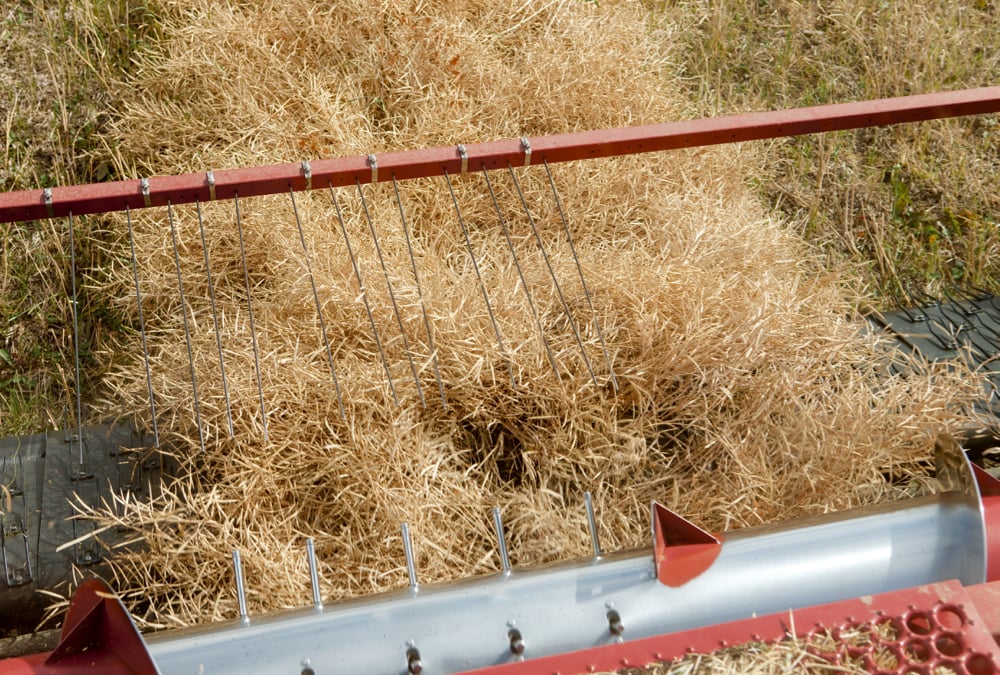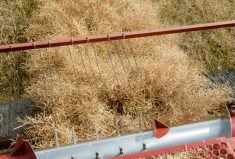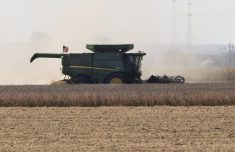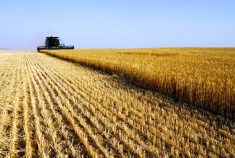Manitoba crop report, as of July 2.
Warm, dry weather conditions allows acres with excess moisture to recover. However, some fields show symptoms of excess moisture stress, including yellowing and slowed crop development.
Southwestern Region:
The Southwestern region experienced a warmer week, but wet, weather continued. Rainfall amounts ranged from 20 millimetres in northern regions to more than 125 mm in southwestern portions of the region.
The Pipestone, Reston, Hartney and Souris areas were among the hardest hit with rainfall amounts now over the previous 10 days, totalling in excess of 300 mm in isolated areas.
Read Also

Alberta harvest wrapping up: report
Harvest operations advanced to 96 per cent complete in Alberta as of Oct. 7, with only a few late-seeded cereal and canola fields remaining, according to the latest provincial crop report.
Crop losses in the area south and west of Highway 2 are still being assessed as water levels drop. Reduced yields are likely due to waterlogged soils, increased disease pressure and nutrient deficiency.
Areas north of Highway 2, and in particular north of Trans-Canada Highway, were significantly drier and able to absorb much of the rain with limited crop injury.
Weed spraying operations are virtually complete for much of the region except for areas south and west of Highway 2. Fungicide applications have just begun on winter wheat, first seeded cereals, field peas, and canola acres.
Many of the early seeded spring cereals acres are caught up to the winter wheat crop; both crops are in the flag and early heading stage of development. Field peas are in the bud to 20 percent flower stage of development while canola growth stages are more variable due to the severe flea beetle pressure and early season dry conditions. Canola growth stages range from four to six leaf to bolting to 20 percent to 30 percent flowering. Fall rye is headed and flowered.
Corn crops are improving as growth benefitted from the recent heat. Soybeans have taken the excess moisture well and are primarily in the third trifoliate stage. Most fields have had one application of glyphosate. However, growth has been slow until the recent heat, especially for earlier seeded soybeans.
Insect activity has included continued flea beetle feeding in canola and cutworm injury in cereals, canola and flax. Alfalfa weevil numbers also increased dramatically last week and growers are monitoring fields closely as populations can be variable from field to field. Bertha armyworm moth monitoring continued to see low numbers this past week.
Pasture and hay growth continues to improve over this past week due to the warmer temperatures.
Northwestern Region:
Rain and heavy thunderstorms affected most areas of the northwestern region, which were recovering from the previous week’s heavy rainfall. Precipitation amounts ranged from 25 mm around Roblin through Swan River and The Pas, with generally higher amounts of 40 to 60 mm in communities east of the escarpment.
Cereals are rated as 65 percent of the acres in good to fair condition and canola at 60 percent good to fair. Winter wheat is headed, 75 percent of the spring wheat acres are at stem elongation, canola is at 10 percent flowering and 70 percent rosette, and 70 percent of soybeans are around the third to fourth trifoliate stage. With the recent rain, many fields are beginning to yellow from excessive moisture. Late seeded, immature crops are most severely stressed and drown outs are evident. Better drained fields are beginning to dry; however, regional soil moisture conditions are mostly at a surplus level. The Roblin to Swan River areas are less affected by excess moisture and crop condition is better overall.
Condition of forage and pasture is rated as 85 percent good to fair. Moisture supply is surplus to adequate. Yields are expected to be average to below average.
Central Region:
Warmer temperatures were welcome for crop growth in the region. A few areas remained dry, but rain fell throughout the region with some areas receiving excessive amounts. Thundershowers were responsible for significant variability within a short distance. Localized flooding and standing water caused crop damage in areas of highest rainfall in the last two weeks, in areas ranging from Starbuck, Headingley, St. Francois Xavier, through Westbourne and Bagot and into the Gladstone area. Westbourne and Bagot received 150 to 200 mm, with the rest of the Portage area seeing amounts of 25 to 75 mm. Some areas in Starbuck, Headingley and St. Francois Xavier received over 150 mm in the last week to 10 days. Much of the region received 12 to 50 mm precipitation over the week; areas to the west and south saw amounts in the lower part of the range.
Windy conditions and rain showers affected herbicide and fungicide applications, but good progress was made this past week as herbicide applications range from 75 percent to fully complete.
Growth is improving on most crops although stands of many crops are uneven. The recent rains will result in an increase of acres with reduced crop stands.
Cereal crops development range from tillering to many in flag leaf emergence and some acres starting to head. The most advanced spring wheat fields may see fungicide applications for fusarium head blight by the end of the week. Leaf diseases are evident, especially in fields with cereal stubble from the previous year.
Most canola ranges from early rosette to bolting and early flower and up to 40 to 50 percent bloom. Most fields received a first herbicide application and many received a second application. Herbicide applications should wind up this week on the latest seeded fields. Flea beetle feeding dropped off in most fields, although still a concern in some with monitoring continuing.
Corn crops are improving with the hot, humid conditions. Many soybean fields are yellowed but are expected to improve with the good growing conditions.
Fall rye and winter wheat have headed. Fungicide applications continue in winter wheat.
Cutworm activity has declined. Diamondback moth monitoring continues and some larvae were found. Trap counts are highest in eastern parts of the region. Bertha armyworm trap counts are low. Grasshopper activity has increased and the headlands of a number of cereal and canola fields were sprayed, mostly in eastern areas.
Baling of first cut hay continues with average yields expected for most areas.
Eastern region:
Crops in general appear to be doing well across the region. With some rain early last week and higher daytime temperatures, crops are growing rapidly. Crop stages are as follows: winter wheat is headed out, canola on average is 50 percent rosette and 50 percent flowering, cereals stems have elongated and head emergence is beginning, soybeans are 20 percent vegetative and 80 percent flowering and corn is showing eight to 10 leaves.
Most herbicide applications are complete. Some second pass herbicide applications on corn and soybean remain but will be done shortly.
Fungicides applications are the current focus.
Insect activity includes some diamondback moth larvae in canola, European skipper larvae in winter wheat and armyworm larvae in ryegrass. No threshold levels for spraying were met. Grasshopper activity has increased with insecticides being applied in winter wheat, spring wheat and soybeans, mainly along the perimeter of the fields.
Haying continues in the Eastern Region with progress varying from five to 25 percent standing, 15 to 50 percent cut and 25 to 85 percent baled or silaged.
Interlake Region:
The Interlake region saw a mix of sunshine and showers during the past week. Rain ranged from 35 to 45 mm and up to 75 mm in the Woodlands area. There is localized flooding of low areas in crop and hay land in the northwest and southwest of the region and areas along Lake Manitoba. However, hot conditions generally allowed for good crop growth across the region.
Annual crops are progressing well. Fungicide application on winter wheat is general across the region as fusarium head blight risk is high. Canola is bolting with sclerotinia control underway in the southern areas and soon to begin in the northern areas of the region. Soybeans are in the third trifoliate and are advancing rapidly. Spring wheat is mostly in the flag leaf stage with some fields starting to head in the south Interlake.
Alfalfa seed crops are in early bloom stage with leafcutter bee release underway. Hot weather on the weekend allowed for excellent bee activity.
Haying operations are general with the majority being harvested as round bale silage. Yields are variable with new stands yielding above average while aged stands have yields below average. Pasture conditions are considered good with water supplies adequate across the Interlake.
















